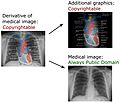Creative Commons licenses facts for kids
The Creative Commons licenses are a set of special rules that creators can use to share their work, like photos, music, or writing. These rules were first released on December 16, 2002, by a group called Creative Commons, which is a United States nonprofit organization. Anyone can choose to put their own creations under these licenses.
There are four main conditions that can be part of a Creative Commons license. Here's what they mean:
- Attribution (BY): This means others can copy, share, show, and even perform your work. They can also use it to create new things. But, they must always give you credit as the original creator.
- Noncommercial (NC): This allows others to copy, share, show, and perform your work. They can also make new versions of it. However, they are not allowed to make money from your work.
- No Derivative Works (ND): This lets others copy, share, show, and perform your work. But, they are not allowed to change your work or turn it into something new. They must use it exactly as it is.
- Share Alike (SA): If others change your work or create something new from it, they can only share their new work if they use the exact same license you used for your original work. This is similar to copyleft.
Creators can combine these conditions to make different types of licenses. For example, a common one is "CC BY-SA." This stands for "Creative Commons Attribution-ShareAlike." If someone uses this license, others can use their work for free, but they must:
- Give credit to the original creator (BY).
- If they make something new with the work, they must share their new creation under the same "CC BY-SA" license (SA).
Understanding the Licenses
It's important to know which license is being used so you understand how you can share and use creative works. Each license tells you exactly what you can and cannot do.
Criticism and Clarity
Some groups, like the Free Software Foundation, have pointed out that the Creative Commons system can sometimes be confusing. They believe it's not always clear which specific license is being used. This can make it hard for people to know the exact rules for using a creative work. They suggest using other licenses, like the Free Art license, which they feel are clearer.
Related pages
- Portions of this article are taken from the Creative Commons website, published under the Creative Commons Attribution License v1.0
Images for kids
-
Aaron Swartz and Lawrence Lessig at the 2002 event for the first release of the licenses
See also
 In Spanish: Licencias Creative Commons para niños
In Spanish: Licencias Creative Commons para niños



